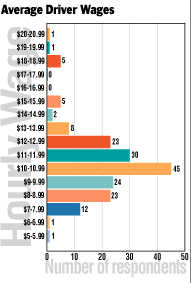America struggles with the school bus driver shortage - continued
| The School Bus Driver shortage! More drivers are leaving the proffession and fewer are signing up. Where have all the school bus drivers gone? And why?
Your Thought
|
By Steve Hirano
Editor/Associate Publisher with Schoolbus Fleet Magazine. First published by Schoolbus Fleet Magazine, original story title, "CONTRACTORS STRUGGLE WITH DRIVER SHORTAGE, LOW RATE INCREASES" published June/July 1999, Copyright �1999, All Rights Reserved. Posted by permission from Schoolbus Fleet Magazine.
Schoolbus Fleet Magazine
Page 2, continued - But even as school systems yield to privatized transportation, they are expected to be tight with their purse strings.
- "More district-owned bus
systems will go private, and, as always, funding will continue to plague
transportation systems and schools," said a South Dakota contractor.
- "School boards are getting impossible to deal with as far as
negotiating prices," said a Wisconsin contractor.
Meager rate hikes
Because of school budget limitations, rate increases have not been
spectacular in recent years. The range of increases reported by respondents. The majority of the increases are between 2 and 3 percent, with an average of 2.2 percent. Few respondents reported increases above 5 percent, while one actually reported a rate decrease of 5 percent.
These meager rate hikes have forced many contractors to sharpen their
pencils. Several mentioned cost-cutting strategies that can take the pressure
off their bottom line.
A Wisconsin contractor said he's exploring the used-bus market and has
also begun buying used parts. Another tactic has been to cancel collision
insurance on his older stock.
Another Wisconsin contractor believes comparison shopping is the best way to cut costs. He has vendors bid for his insurance program and compete against each other for bus part sales. He also has reduced his reliance on vendors for promotional materials by doing the work in-house.
In Minnesota, a contractor has implemented "constant monitoring of
population shifts to see if routes remain efficient." He also cited strong
communication with school districts about possible areas in which costs can be reduced.
A contractor in Montana who reported a 1.6 percent rate increase has
actively pursued several cost-cutting strategies. Included in his program:
reduction of one position; reorganization of the company to streamline
functions; installation of locking covers on thermostats; caulking and sealing of the facility; and improvement of the preventive maintenance program.
A repercussion of tight market conditions can be reduced wage hikes for
employees, which was the case at a Pennsylvania school bus company. In
addition, the contractor also eliminated one full-time position. Attrition can also be used to keep costs under control. More than one contractor reported not replacing employees who retired or left under other circumstances.
On the equipment side, several contractors mentioned buying larger-capacity buses and doing more of their own maintenance. Minimizing the options on buses is another way of cutting costs.
Even small changes can make a difference. A contractor in Maryland has
reduced fuel costs by studying routes to reduce deadhead mileage. And a New
York contractor keeps a tight rein on discretionary expenses, such as
stationery and supplies.
Bare to the bone?
While reducing overhead is one response to cost pressures applied by school districts, it's not always feasible to cut costs and maintain service
levels.
- "When you are cut to the bone, it's difficult to cut more without
cutting into maintenance and other necessary items," said a New Jersey
contractor.
A Wisconsin contractor said she's had to move in the opposite
direction, increasing her overhead to stay in business.
- "If anything, we have increased our costs to attract and retain drivers," she said, citing higher wages and implementation of a 401(k) pension plan.
A Pennsylvania contractor has begun offering bonuses to drivers who have perfect attendance for 40 days, which helps reduce the cost of using substitute drivers.
Driver wages rising

While the hourly wage ranges from approximately $5 to $20, the vast majority of school bus contractors pay between $8 and $13 per hour. (Schoolbus Fleet Survey)
|
Although wages may not be the primary factor affecting driver retention,
compensation always influences employee satisfaction. Chart 4 breaks down
average hourly wages reported by the respondents.
It's clear that few contractors believe that minimum-wage level
compensation will be acceptable to school bus drivers. In fact, about twice the minimum wage is close to the survey average of $10.67 an hour. That's up 94 cents from the $9.73 per hour reported in our 1997 contractor survey
(June/July 1997, pgs. 28-36.)
As you might expect, driver wages vary widely. A dozen contractors (or 6.6
percent) say they pay from $7 to $7.99 per hour. Meanwhile, one particularly
generous contractor reported an average hourly
wage of $20.
However, about two-thirds (122) of the 181 companies that responded to the
question pay between $9 and $13 per hour. The most common average hourly wage
is $10 to $10.99. Nearly one in four respondents (24.9 percent) fall within
that range.
There's a sharp drop-off above the $13-an-hour mark, with only 22 (12.2
percent) paying more than that. Some contractors indicated that wages will have to be increased to alleviate the driver shortage.Continued
| 


